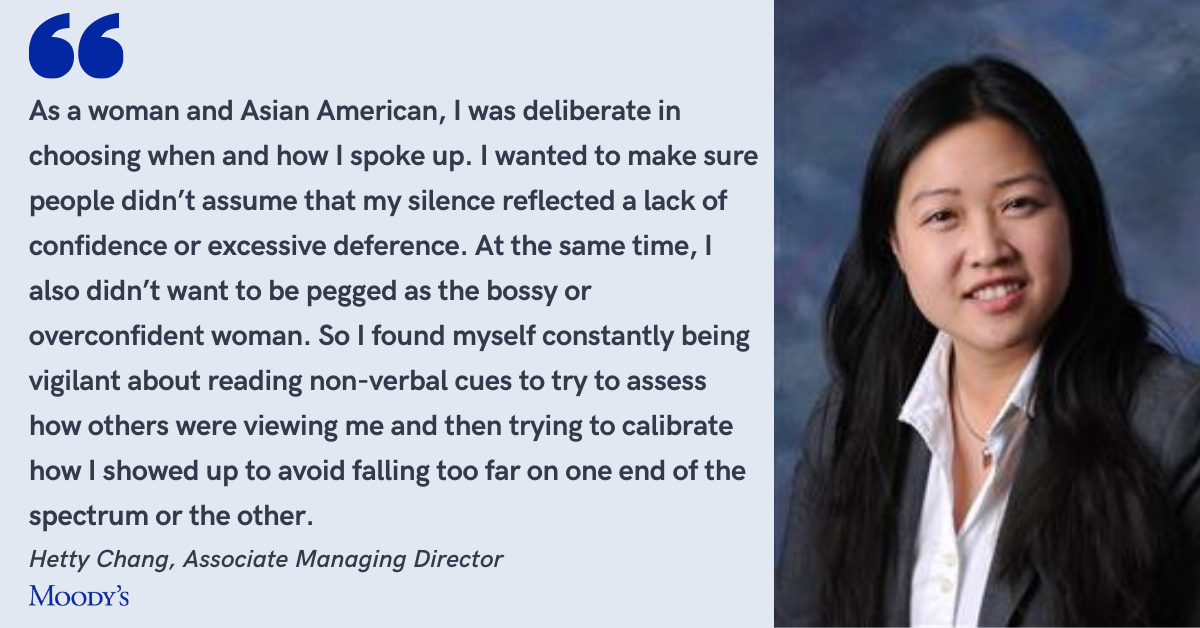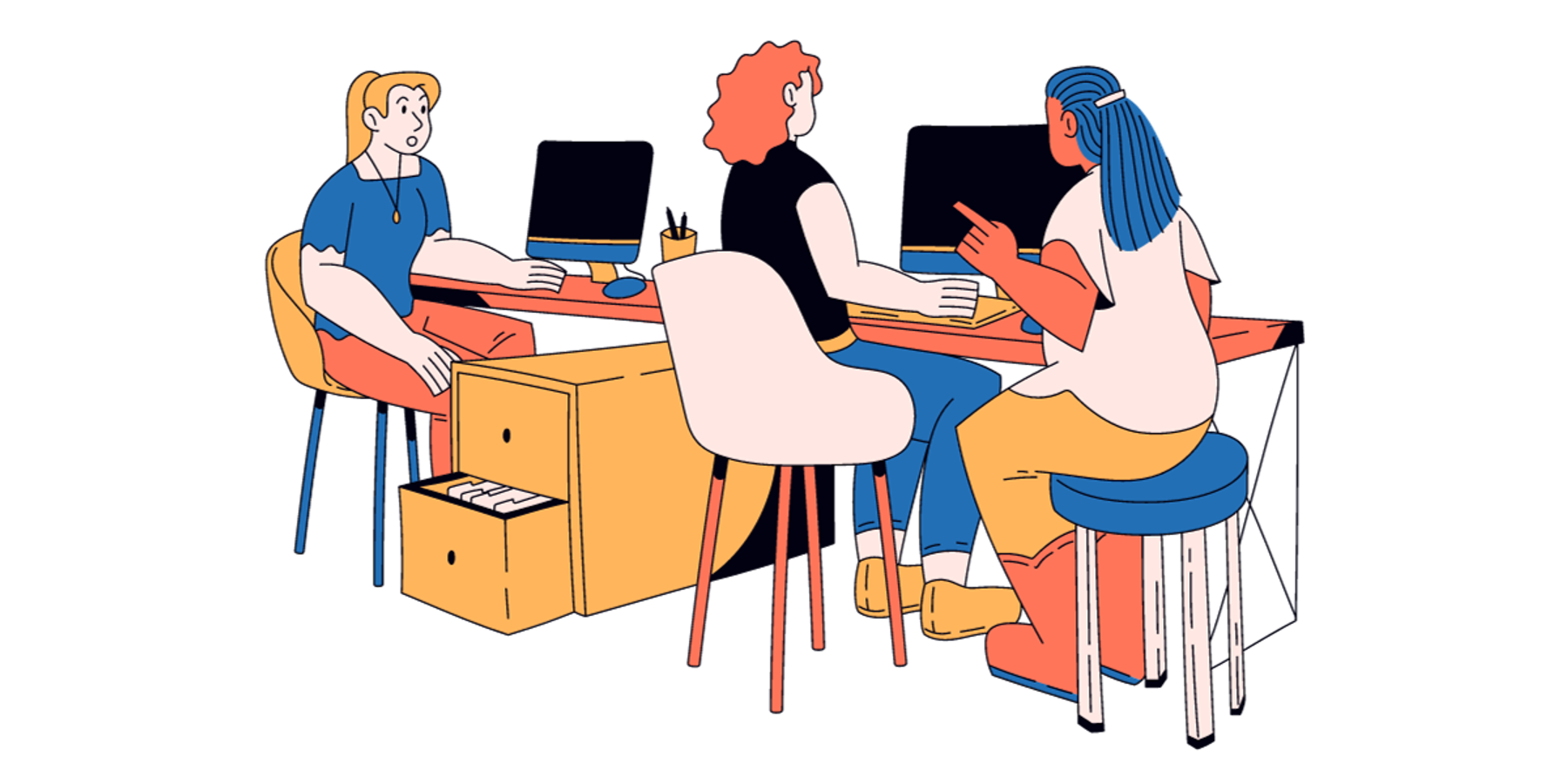No open-toed shoes. No slang in emails. No showing up to work more than 15 minutes late. These are all implicit workplace norms Hetty Chang didn't know at first but quickly picked up on in her career 18 years ago.
As an Associate Managing Director at Moody's, the risk assessment firm, Hetty has been reevaluating who those norms serve, as well as how companies like hers can maintain their culture and traditions while also building towards a more inclusive environment.
"We have to work on making sure there's job satisfaction, that you're creating a psychologically safe space. If we're focused on outcomes, then sometimes it's about being more flexible on cultural norms. When I make decisions and choices, it's more about outcomes versus how I expect we're supposed to get there," she says.
We sat down with Hetty to talk about how she's developed her own views on what works at work (and what doesn't), what role cultural norms can serve at an organization, and what advice she has for navigating them as a leader looking to build an environment where everyone can thrive.
Understanding her own perspective
Hetty would call herself more conservative when it comes to expectations for what work should look like. "That might go back to being a woman or being a minority, where it's easier not to try to push the boundaries because that way I can say, 'Okay, I fit in the box, I'm not making any mistakes,'" she says. "It just feels safer to me."
"I acclimated to the professional world with a level of anxiety that comes from feeling like you have to toe a fine line because of the fear that violating an expectation would limit career growth," says Hetty. "As a woman and Asian American, I was deliberate in choosing when and how I spoke up. I wanted to make sure people didn't assume that my silence reflected a lack of confidence or excessive deference. At the same time, I also didn't want to be pegged as the bossy or overconfident woman. So I found myself constantly being vigilant about reading non-verbal cues to try to assess how others were viewing me and then trying to calibrate how I showed up to avoid falling too far on one end of the spectrum or the other."
To Hetty, professional has always meant maintaining a professional appearance, and doing her work without complaining, waiting patiently to rise through the ranks.
That's not what professional always means to others on her team, though, and Hetty says she's recognizing how important it is to adapt.
"Implicit business norms are where unconscious bias really comes into play," says Hetty. "Everyone comes from a different context and has different motivators. I might not know I'm holding something against someone. So I try to think of ways to be fair by almost taking me as a person out of the equation of making certain decisions."
Hetty has been unpacking some of her assumptions about what professionalism looks like at work thanks to a combination of working with her team and some inclusion training that she's taken as a manager. Here are a few of those examples:
- Asking for promotions versus waiting for them. "For someone of my generation, you get promoted once you prove yourself, and if you push for it too early, that's seen as presumptuous," says Hetty. When newer employees were vocal about wanting raises and promotions, it initially felt off to Hetty. But then in a training, a presenter shared that millennials have much higher student loans than previous generations and that they were raised to ask for what they want. "That was the first time it made me pause, because that was definitely a bias in my own mind. It made me step back," she says.
- Not putting your camera on during meetings. When the pandemic started, senior leaders like Hetty quickly realized that their junior employees weren't always turning on their Zoom cameras for virtual meetings. "It was a big issue. Initially, I thought, 'You should act like you are in a conference room at the office, where we can see each other,'" she says. "Then someone raised the point that some people are living in small apartments, might be sharing space with a roommate, they might not want people to see where or how they live, or they might just not have a very good wifi connection. She's now changed her expectations: "Being strict about turning on your Zoom camera should be the least of our worries."
- Using emojis and acronyms in email. The first time Hetty got an email with a colloquial acronym she didn't understand, she didn't respond well. "At first I wondered, 'Why would you write an email like that to your boss?' Then you have to step back and say, 'This is my lens, but this is what they think is acceptable, and I can't sit here and judge. That's the bias aspect,'" says Hetty.
As she continues to push herself and her team, Hetty has taken on a new approach to figuring out what workplace norms work for everyone: "I'm not going to judge that person just because that's the context within which they've developed their idea of what professionalism means."
The role norms serve
Not all company norms are bad, of course. One of Hetty's favorite Moody's traditions is how they run decision-making.
"When we make rating decisions, it's by committee, and everyone gets a voice, everyone gets to vote," she says. "We always make sure the most junior person votes first, so they don't feel pressure to voice an opinion similar to their superiors."
Other norms can help make people feel comfortable. Sometimes that means wearing closed-toe shoes and tucking in shirts to fit into the standard American business professional cultural expectation, and sometimes that means being flexible to fit into someone else's.
Hetty explains how these flexible norms played out at client meetings. "Generally, we'd be there in suits, that was part of our image. But there were situations where the representatives we were working with said, 'Hey, you know what, I suggest you don't come in in your suits. Button-downs, slacks, they'll be more comfortable if you're more comfortable,'" says Hetty.
"Again, it goes back to the relationship and the image you're trying to portray, and being sensitive to that one way or another, because you will be judged," she adds.
What conscious leaders can do
Managers who want to take away some of the harmful aspects of implicit norms can work to make them more explicit and to help employees navigate them.
Instead of assuming that someone will take a new hire under their wing and tell them what everyone wears to the office, Hetty suggests being upfront with them.
"Be honest and transparent about, 'Hey, this is how this type of professional behavior might be viewed or interpreted, right or wrong; this is the reality of the particular environment you work in,' whether that's how they dress or what time they show up or how they speak up in a meeting," she says.
After those norms are out in the open, they're easier to manage around. Hetty gives an example of a working parent who can't start work until 9:15 a.m. because that's when they get back from dropping their kids off at daycare. "It's up to me as their direct manager to help them, protect them from any judgment about that," she says, adding that she would advise them to block their calendar off until 9:15 a.m. each morning so that their coworkers know they're unavailable then and aren't left looking for them.
Managers can also strip away subjectivity as much as possible. A good example of this, Hetty says, was a recent discussion she and her fellow managers had about moving a special leadership program from a nomination process to an application process. "As managers, we've been trained in diversity," says Hetty. "But how do I know I am being fair? You don't know what you don't know about your own biases." she says.
And most importantly, leaders can listen. "Ask questions without being intrusive, and lay a safe foundation without overstepping those bounds," she says.




